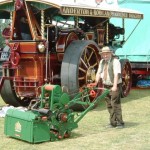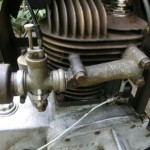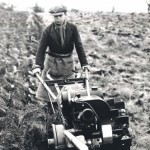Home › Forums › Groundcare Machinery › Grass Cutting Machinery › Mystery lawnmower!
- This topic has 6 replies, 4 voices, and was last updated 3 years, 3 months ago by
 hdtrust.
hdtrust.
-
AuthorPosts
-
March 21, 2022 at 7:00 pm #38673
hillman700
ParticipantGood evening,
I’ve attached some pictures of a mower a got today. I can’t see any kind of ID plate on it or make. It’s a 30 inch roller, unbelievably heavy and also gas a sit on roller. I’ve been through a lot of Google images but can’t see anything like it.
Any help would be very much appreciatedThanks
March 21, 2022 at 10:05 pm #38677 hdtrustParticipant
hdtrustParticipantHi
What you have there is a pre war Atco, your model was made from 1939, there was three sizes in the range, 24 inch, 30 inch and 36 inch machines, the range was actually called the Atco Heavyweight range
They were designed for extensive areas of grass on large estates, cricket, football pitches and playing fields. Yours had the capability of cutting up to 1 acre per hour.
The engine is an Atco-Jap 4 stroke 600 cc.Which had a mechanical oil pump, Amal carb and a Wico magneto, and a fan cowl cooling system. The rear roller is split into three, which has a full differential drive for easy turning.
The cutting cylinder should be six bladed, and there is a cutter release which enables the machine to run without the cutting cylinder engaging so the machine can be used to roll only.
The front rollers should be in 5 sections made of cast iron, very heavy. As can be seen in the picture which is from the Atco 1939 brochure, the grass box sits within a frame so that when emptying, it tips forward.
The finish on this range of machines included chromium plating on the exhaust pipe, handles and controls.
Hope this helpsMarch 24, 2022 at 3:41 pm #38705 wristpinParticipant
wristpinParticipantThe engine is an Atco-Jap 4 stroke 600 cc.Which had a mechanical oil pump
Interesting to see 4-stroke with an oil compartment in the fuel tank, but no sign of a return pipe, so was it a total loss system requiring regular replenishment?
Also interesting that the later post war wide cut machines were 28 and 34” . I wonder what the thinking was to drop the 36” machine when all the opposition still offered one of that width?March 31, 2022 at 4:19 pm #38750 hdtrustParticipant
hdtrustParticipantGood afternoon Angus, yes mowers before your time! The machine above had a total loss system, the oil went via a pipe to a cup box feeding the bearings on the rear roller.
The reasons for changing the width of the cutting cylinders, was because of flex from the cylinders to the bottom blade. Atco’s construction was always lighter, then their counterparts eg Ransomes.
Infact I’ve often heard in the trade that Atco after the war could never produce a professional machine, but I will leave that one for others to argue the toss!
Regards
AndrewMarch 31, 2022 at 10:49 pm #38751 wristpinParticipant
wristpinParticipantQuote. “The machine above had a total loss system, the oil went via a pipe to a cup box feeding the bearings on the rear roller”.
I think that we are at crossed purposes ; I was referring to the engine. Your initial post refers to a JAP engine with an oil pump and it was my assumption that this looked after the internal engine lubrication. So was the oil in the handle bar mounted tank supplying engine lubrication, roller bearing lubrication, or both? I would venture to suggest that the oil pump on the JAP engine with its motorcycle ancestry was likely to be primarily, if not solely, to look after the engine’s internal lubrication.
Cutting cylinder width. I had heard it said that for practicable purposes 36” is the maximum length, and that any thing wider might require to be of an impracticable diameter to maintain rigidity. You will remind me that Ransomes did make a ride on machine with a 40 or 48” cylinder, but not for long; and that Allett did, or still do offer a 42” machine; so presumably they got around the “over 36” flexing issue.
April 1, 2022 at 6:43 am #38752 trusty220Keymaster
trusty220KeymasterIf it’s anything like the Blackburne engine on my old Trusty the engine lubricating oil was indeed a total loss system with no scavenge pump to return the used oil to the tank. These old engines seem to be built like that and some of the old photo’s I’ve got from the 1930’s show Trusty tractors working with plenty of exhaust smoke. Not very good for the environment or the pocket!
April 1, 2022 at 10:22 pm #38753 hdtrustParticipant
hdtrustParticipantHi wristpin, yes cross purposes, The oil in the tank supplied the engine, Cup boxes were on the inside sides of the mower feeding the rear rollers
The width of the cutting cylinders, the largest width was 48 inches which went out of production before the 1880s,42 inches is the largest width used today, but more common to find 36 inches
-
AuthorPosts
- You must be logged in to reply to this topic.




